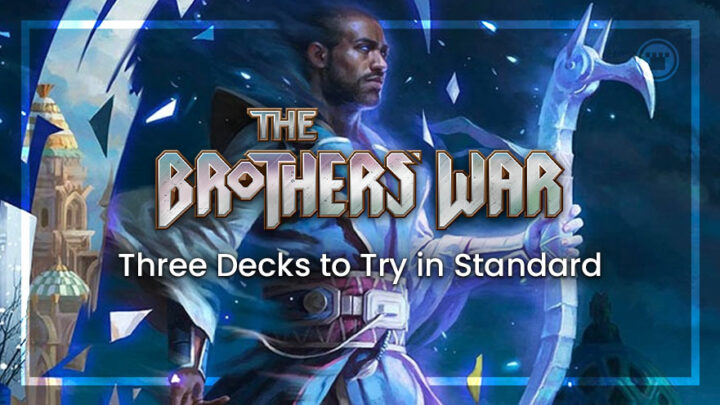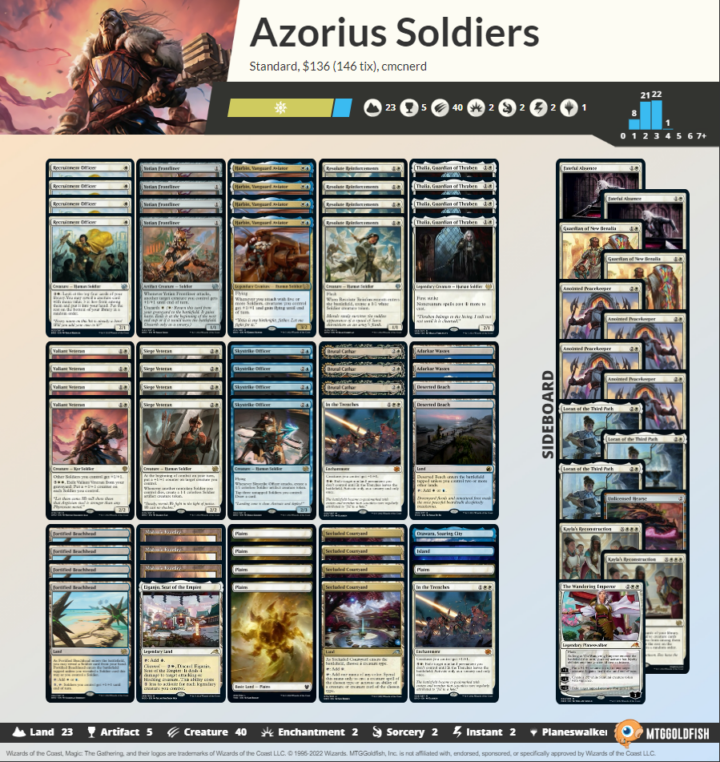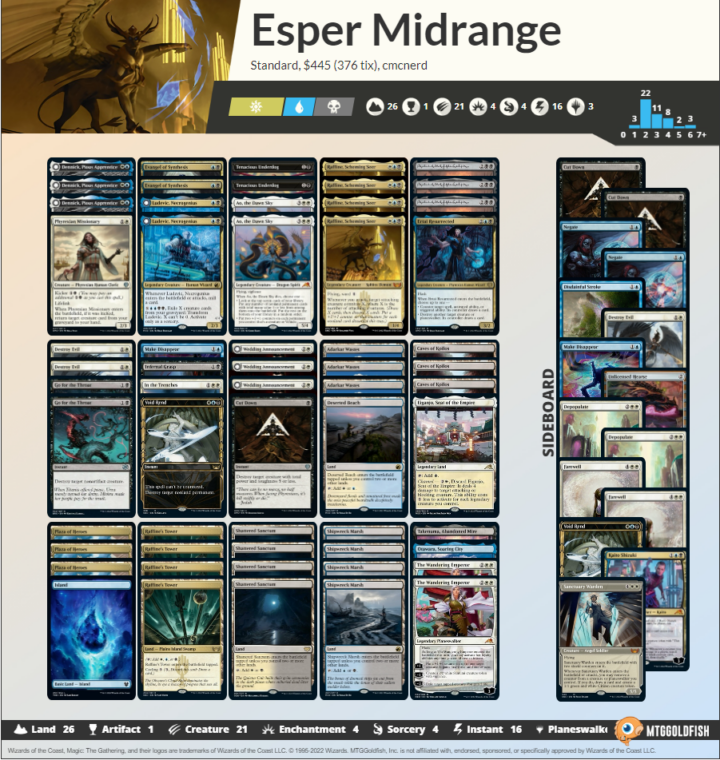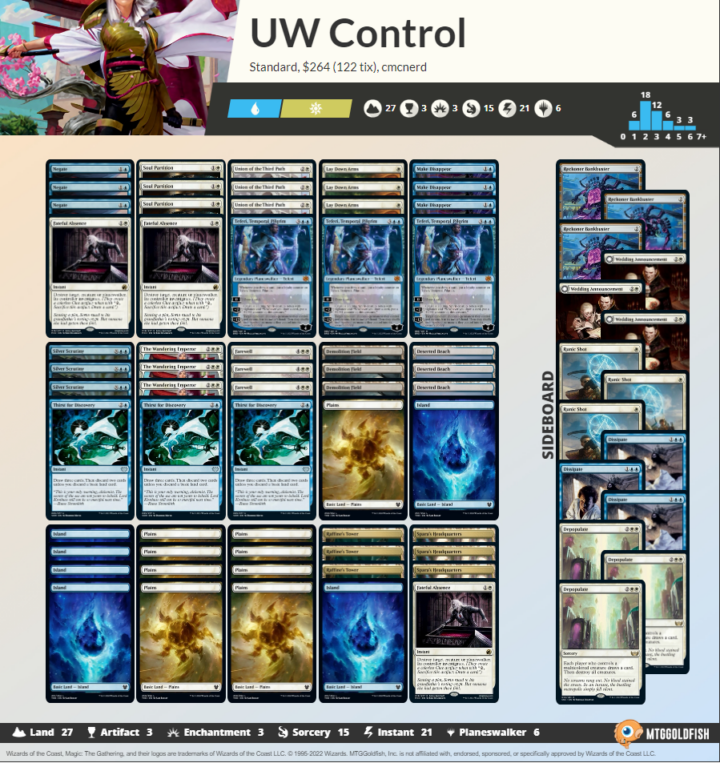Standard has had a few weeks to percolate since we first touched on it after The Brothers’ War released. But Standard is a big, wide format right now, with many viable archetypes floating around. And since it’s still too early to gauge which decks will settle into the various tiers, I’m not even going to try quite yet.
Instead, here are three different decks falling into three different archetypes: Aggro, Midrange and Control. This way, no matter what kind of Magic you like to play, there will be something for you.
Aggro: Azorius Soldiers
White Aggro decks are nothing new, but when you want to augment those decks with a second color, most folks will instinctively reach for red. Then, The Brothers’ War came along and made white/blue the Soldier archetype, with some pretty powerful payoffs for adding Islands into your deck.
Those payoffs are Harbin, Vanguard Aviator and Skystrike Officer. Harbin is super aggressive on his own as a two-mana 3/2 flyer, which by itself would be enough to include them in the deck. But once you get to the point where you can trigger his ability, that’s often lights out for whoever is across the table from you.
Skystrike Officer costs one more mana (but only one colored mana, making it easier to cast on curve) and flips the power and toughness of Harbin, making it seemingly a little less aggressive. But the officer is an army in a can, pumping out soldier tokens with every attack while turning any soldiers you have lying around into a card draw engine.
But the blue cards aren’t the only ones in the deck that BRO adds to the format. Yotian Frontliner is often going to die pretty quick, but the point of it is to pump one of your other more immediately impactful creatures through an attack to get them out of range of easy trades.
Recruitment Officer is a Savannah Lions that can refill your hand, and one of the best mana sinks possible for a deck like this. Valiant Veteran is a super-efficient anthem for the rest of your team, making going wide a quickly lethal strategy. A Veteran plus In The Trenches on board suddenly makes all the little 1/1s truly threatening, with Trenches doubling as eventual removal to get a troublesome blocker out of the way of an alpha strike.
Siege Veteran serves double duty. It slowly pumps up whatever you need, yes, but its ability to keep your army staffed even in the face of removal and board wipes ends up being a coffin nail for your opponents.
And don’t forget the utility of Fortified Beachhead, pumping your team in a pinch, and Mishra’s Foundry, often being that extra blocker or attacker that swings combat math in your favor. Aggro decks usually have a pretty good place near the beginning of different Standard formats, and if you’re looking for a go-wide option that features a lot of evasion and redundancy, Azorius Soldiers fits that bill perfectly. The only thing I think I want to change so far is finding some room for Myrel, at least in the sideboard, if nothing else.
Midrange: Esper Raffine
So, this deck isn’t really a shocker or anything. Esper Raffine has been a force in Standard ever since the eponymous crime lord burst onto the scene in Streets of New Capenna. The Brothers’ War has provided “the best deck” some nifty new options, as well as one of the premiere removal spells now in the format.
First, let’s address a card we’ll be seeing a lot of for its current tenure in Standard: Go For the Throat. Essentially a conditional upgrade over Infernal Grasp, the nonartifact clause on it isn’t really all that limiting in current Standard.
This still takes out opposing Sheoldreds, Raffines and pretty much anything from the other two decks in this article (you’re safe for now, Yotian Frontliner). Turns out that removal that’s perfectly playable in Modern tends to work out well in Standard, too.
Evangel of Synthesis has seen some play recently as a decently aggressive two-drop that plays quite well with both Toluz, Sheoldred and Ludevic, Necrogenius. Gix has also received some face time, with Sheoldred offsetting any potential life loss. He also provides a nice mana sink for when the games start to stall out.
Esper shells are pretty mutable right now while maintaining a high level of quality. You can go more midrange creature-based with Ratadrabik, focusing on Legendary creatures, or more controlling with permission and planeswalkers. The Brothers’ War served only to fortify the deck and give it some options. It remains to be seen if anything else will be able to challenge its place in the top tier of Standard.
Control: Blue/White Control
Straight-up Draw-Go Control hasn’t been too popular in recent Standard, with most Control decks opting for a slightly more proactive approach to keep up with the sheer quality now found in creature-based decks. With The Brothers’ War, however, the stars are aligning in such a way that it might be time to once more sit back, relax and watch your opponent figure out how to wade through your hand of permission and board wipes once again.
Lay Down Arms is a classic Blue/White Control removal spell, with a downside that we really don’t care too much about. We have plenty of Plains in the deck to scale the spell up, and the life gain for our opponent is mostly an afterthought.
Lifegain for ourselves is not, however, as our life is often a resource we use to buy some draw steps while we find a board wipe. This is where Union of the Third Path comes in. We’re pretty good at keeping our hand stocked, so this is often going to be three mana for “draw a card and gain four-plus life”, which is everything we want against the more aggressive decks in the format.
Well, what we want is Farewell, but Union buys us the time to get up to casting six-mana spells handily. Soul Partition also excels at buying us time. It’s not a permanent answer or anything, but it is a temporary answer to every nonland permanent, once again buying us all the time we need to build up to our more expensive haymakers.
Speaking of haymakers, this is the deck where Teferi, Temporal Pilgrim can really shine, building up to its ultimate ability right quick. Teferi’s -2 is also a major win condition for us, as that 2/2 vigilant creature can grow huge in the space of a single turn when paired with cards like Silver Scrutiny and Thirst for Discovery. The Wandering Emperor also shines in this style of deck, allowing you to react as needed to whatever your opponent does.
Decks like this can often seem a little underwhelming as a decklist, feeling largely underpowered on a card-by-card basis compared to flashier midrange decks or tap-out control variants. But what a deck like this excels at is setting up huge value plays, trading single cards of theirs for multiple of their opponent’s and setting up crushing inevitability.
I would suggest getting some goldfishing reps in with a deck like this, or trying it out in places where you can get used to it before playing for any kind of real stakes. This is a deck you need to know pretty well to avoid timing out.
Control can be very powerful, but it’s often a little slow, as well.
End Step
That ended up being a bit more blue-white heavy than I thought it would be when I set out to start writing this article. What can I say — it’s a strong color combo right now! That’s not to say there aren’t strong decks in other colors, of course, but these are the three decks that caught my eye this week. I promise next time I’ll include some green and red in there (Hey Editor, please hold me to that if I forget. Also leave this note in. Transparency in media! [Editor: But I don’t like green and red… Putting a response because transparency in media]).
Standard does feel rather powerful right now, with every deck capable of making game swinging plays on nearly any given turn. The format also churns pretty, so I fully expect these lists to shift around, waxing and waning in effectiveness as different strategies rise and fall. Standard may not be the premiere format of Magic that it once was, but it’s still plenty of fun.

Chris is the Marketing Communications Coordinator (and editor of the blog) at Card Kingdom. He would like to apologize to his son for not holding onto more cards from when he first started playing, as that likely would have paid for college. He enjoys pretty much all formats of Magic, but usually ends up playing decks that make other people dislike playing those formats with him.




